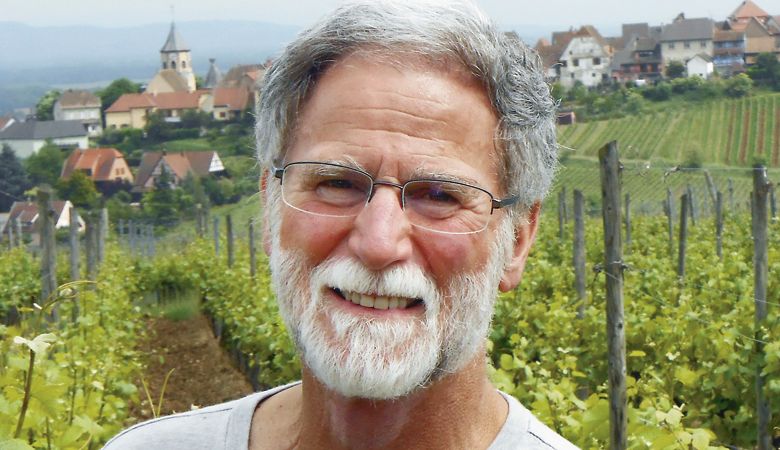Q&A: Bob Betz MW
Washington leader answers OWP
Chicago native Bob Betz graduated from the University of Washington with a BS in zoology in 1970. Around the same time, his pursuit of winemaking began when he and his wife, Cathy, explored European vineyards to better understand crafting fine wine. For 28 years, he worked at Ste. Michelle Wine Estates in communications, education, quality management and production, eventually retiring as vice president of winemaking research. In 1997, he founded Betz Family Winery. For 20 years, he led the Woodinville winery, where he is now its consulting winemaker and winemaking consultant for other Northwest wineries. Betz holds the degree of Master of Wine (MW), a designation awarded by the Institute of Masters of Wine in London. With a pass rate of about 12%, it’s a grueling process that earned him two additional distinctions: the Villa Maria Award, for the highest score on the viticultural exam; and the Robert Mondavi Award, for the highest overall score in all theory exams.
How has being a Master of Wine informed your winegrowing and winemaking?
BB: The great benefit to the MW program is a greater awareness of the global wine world. Not just vineyards and winemaking, but the range of sales, marketing, cultural, financial and historical aspects to wine production. [About] 60% of the theory exams focus on vineyards and winemaking, but the balance delves into all sorts of directions: labor supply/mechanization, consumer trends and preferences, wine and health, social media…
The vineyard and winemaking questions reflect the quickly changing global trends: No longer is it sufficient to know Bordeaux, Burgundy and Champagne as it was decades ago, but candidates need to grasp varieties, sites, appellations, winemaking techniques of the increasingly important wines of Sicily, China, Greece, Argentina … as well as the classics.
The globalization of wine also presents the opportunity (challenge) in the tasting/sensory exams. It’s essential to know the indigenous grape varieties and techniques of so many vineyard areas, but also how the classic varieties differ in their expression from these diverse producing areas. Cabernet Sauvignon’s expression certainly differs from Bordeaux and Napa to Bolgheri, Maipo and the Columbia Valley.
The Institute has become a global organization in the past couple decades, with MWs from London to Singapore, Argentina to India. With that growth has come the expectation for candidates to understand the diversity of wine production.
What can a large winery teach a small winery? What can a small winery teach a large one?
BB: So much is happening globally, at all size levels, that we can all learn lessons from each other. Winemaker experimentation has never been more vigorous, technical education has never been as widespread, and our analytic tools have never been more precise or available. Small wineries can take advantage of the pioneering vineyard work and cellar techniques developed for efficiency by large wineries.
But small wineries have been teaching large producers the advantages of precision and focus on detail. Small wineries have very few advantages, and perhaps their most important advantage is that they can know every barrel; large wineries are incorporating this attention to detail for high-end bottlings.
Betz Family Winery’s foundational wines are Bordeaux- and Rhone-style reds, but does Betz have a Pinot Noir program?
BB: Yes, we founded the company with a precise focus on Bordeaux varieties. After 45 vintages in the industry, I still think Cabernet Sauvignon is Washington’s greatest red variety. Columbia Valley Cabernet Sauvignon, at its best, is compelling, complex and complete, and capable of going the distance. However, Betz Family Winery for the past four vintages has contracted with several premium Oregon growers to source small amounts of really terrific Pinot Noir grapes. Bottled under the SU NU label (having fun with French abbreviations and paying homage to the special soils below the vines) the Pinot Noirs are bottled by vineyard as well as an Oregon blend of vineyards.
What is the latest wine that surprised your palate? Any Oregon favorites?
BB: Probably because of the MW rigors, my tasting range is globally driven. I’ll try wine from anywhere, and I’m constantly on the lookout for wines that over-perform their origins or price. I recently had a $9 Jumilla (made from Mourvedre, Cabernet Sauvignon and Syrah) that would compete with wines two to three times its price. Pricier but no less of a bargain have been a range of vibrant, complex Chardonnays from the Maconnais; not as dense as more acclaimed appellations in Burgundy but at a fraction of the price. Great recent discoveries have been a New Zealand Syrah (Trinity Hill Homage from Hawkes Bay), single-vineyard Grüner Veltliners from Alzinger in the Wachau of Austria, and a surprising méthode Champenoise sparkling from Wiston Estate of Sussex, England. Oregon is always on the short list, for both Pinot Noir and Chardonnay.
Any exciting new projects on your horizon?
BB: We sold the winery a number of years ago, but I stayed on as winemaker for a couple more years, and still retain a consulting winemaker role; working with winemaker Louis Skinner is always satisfying as he brings new strategies, cellar protocols and fruit origins to the table. I have a few other West Coast clients that help keep the mind buzzing. At this point, I’m most eager to get traveling again, returning first to the vineyards in Tuscany; the 2020 trip was cancelled due to the pandemic. [The year] 2021 is the 50th anniversary of my first time there, and I can’t get enough of Sangiovese in my veins.











